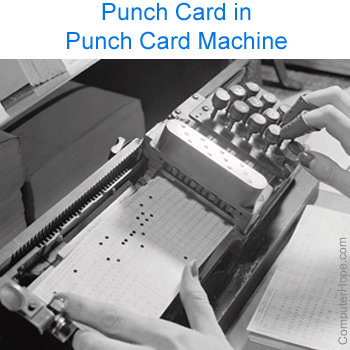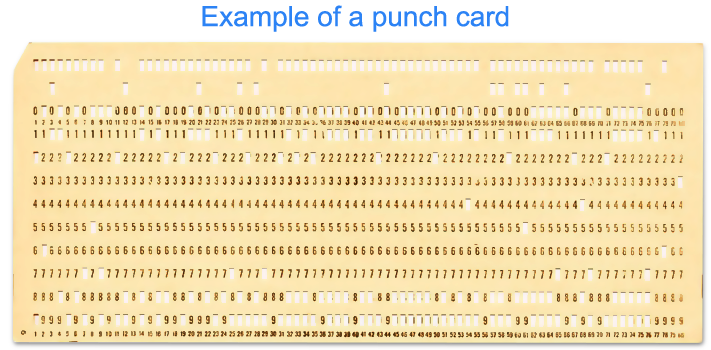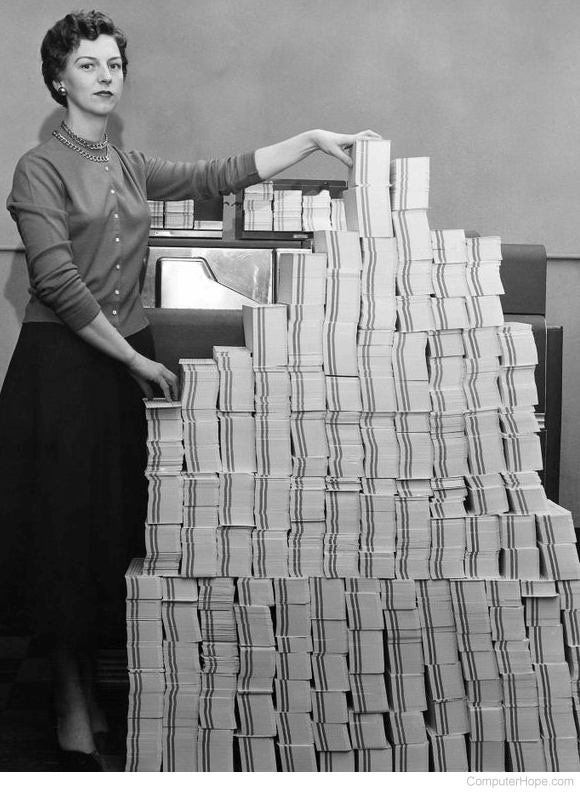Punch card

Punch cards (or "punched cards"), also known as Hollerith cards or IBM cards, are paper cards where holes may be punched by hand or machine to represent computer data and instructions. They were a widely used means of inputting data into early computers. The cards were fed into a card reader connected to a computer, which converted the sequence of holes to digital information known as machine language.
Using these cards was an early method of storing information (e.g., number of votes made in an election) and when combined with multiple cards could store a program. For example, an early computer programmer would write a program by hand and then convert the program to several punched cards using a punch card machine. The programmer would then take the stack of cards to a computer and feed the cards into a card reader to input the program. Pictured is an example of a woman using a punch card machine to create a punch card.
How did punch cards work?
Using a punch card machine like that shown in the picture above, data can be entered into the card by punching holes on each column, representing one character. A typical punched card had 80 columns which meant it could store 80 bytes of information. Below is an example of a punch card.

Once a card is completed or the Return key is pressed, the card technically "stores" that information. Because each card only holds so much data, writing a program using punch cards (one card for each line of code) requires a stack of punched cards.
To load the program or read punch card data, each card is inserted in a punch card reader to input data from the card into a computer. As the card is inserted, the punch card reader starts on the top-left side of the card, reading vertically from top to bottom. After the card reader has read a column, it moves to the next column. As the reader reads the information, it is written to a computer's memory. After all cards were loaded into memory, the computer would be instructed to execute the code. If information were outputted (printed), it would be outputted as punch cards.
The largest punch card program was from the 1950s SAGE air defense system, which used 62,500 punched cards (around 5 MB of data). In the picture below, a woman stands next to the punch cards used in this program.

One of the users' biggest fears about punch cards is dropping them. If these cards were dropped or got out of order, it could take days or weeks to get the program back in order. Sometimes, putting the program back into order wouldn't be possible or worth the time.
Why were punch cards used?
Early computers could not store files like today's computers. If you wanted to create a data file or a program, the only way to use that data with other computers was to use a punch card. After magnetic media was created and became affordable, punched cards stopped being used.
How can a human read a punch card?
Most punched cards printed at the top of the card what each card contained. For these cards, you could examine the top of the card to see what was stored on it. If an error was noticed on the card, it would be recreated. If there was no card text, the human could use a mode on the punch card machine to read and print text to the card.
To read the card manually, you'd need to know how the card was created before it could be read. There were many ways these cards could be created. Some worked like todays computers, which used codes similar to ASCII (American Standard Code for Information Interchange) to represent different characters. For example, with ASCII, the letters in "hi" are codes 104 and 105, which when translated into binary is 01101000 and 01101001.
History of the punch card
Punched cards were used as early as 1725 for controlling textile looms. For example, Joseph Marie Jacquard used punch cards with the Jacquard Loom to create a self-portrait woven in silk in the 1800s. Semen Korsakov later used punched cards to store and search for information in 1832. Later, in 1890, Herman Hollerith developed a method for machines to record and store punch card information for the US census. He later formed the company we know today as IBM.
Terms relating to punched cards
As with most technologies, there are many terms relating to punched cards. Below are these terms with a brief explanation of each term.
- Card - Card was a short abbreviation used for a punched card.
- Card code - The code or instructions that the punched holes represent on the cards.
- Card column - Also called a punch column, a card column is a vertical line of punch positions on a card column.
- Card deck - Also known as a card pack, a card deck is the name of a collection of punched cards.
- Card feed - The part of the punch card reader that moves the punch card from the card hopper to the card path.
- Card field - The specific combination or positions of punched holes on a punched card.
- Card hopper - The part of the punch card reader that holds all of the punched cards waiting to be processed. Not to be confused with the card stacker.
- Card jam - A malfunction in the card reader when one of the cards gets stuck in one of its parts (e.g., card path or card track) and prevents the machine from continuing to work.
- Cardless system - A term given to a system that works without a card reader or card punch.
- Card path - A part of a card reader or an attachment where cards are moved and guided.
- Card punch - A computer-actuated punch that does the hole punching in a punched card.
- Card reproducer - Device capable of reproducing all or part of the data on punched cards.
- Card row - Also called a punch row, a card row is a horizontal line of punch positions on a card row.
- Card sorter - A device that sorts punched cards based on the hole patterns on the card.
- Card stacker - The part of the punch card reader that holds all of the cards after they are processed. Not to be confused with the card hopper.
- Card-to-tape - Devices initially used to transfer punched card data to punched tape and then later used to transfer punched card data to magnetic tape.
- Card track - The portion of the card reader that moves a punched card through the device.
- Chad - The material that is cut out when punching a hole.
- Punch card reader - Also called a card reader, a punch card reader is a hardware device capable of reading or sensing the holes in a punched card. As the device read the holes, it could translate them into machine language that a computer could use.
- Punch position - The defined area on a punched card where a hole may be punched.
Are punch cards input devices?
No. The cards by themselves are not input devices. However, the punch card reader is considered an input device because it takes data from the punch card and sends it to the computer.
Are punch cards still used?
Punch cards were the primary data storage method in the early 1900s. Other storage devices started replacing punch cards in the 1960s, and today, they are rarely used or found and are considered obsolete.
Video of the IBM 029 punching machine
The below YouTube video from CuriousMarc shows a restored IBM 029 creating punched cards to give an example of how these machines and punched cards were used.
What replaced punch cards?
Magnetic tape was the first storage that widely began replacing punched cards. As this happened, card-to-tape devices like the ones used for punched tape became popular for transferring punched card data to magnetic tape.
Accounting machine, Card, Card punch, CHAD, Hardware terms, Input device, Obsolete, OMR, Punch tape, Reader
